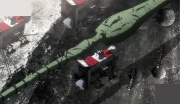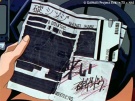KuMoHa42

|
"We've seen it. The proof of its construction was very useful." |
The KuMoHa 42 number 42001 is a Japanese single-car electrical train manufactured in 1933, and which served into commercial service until 2003 on the Onoda Line connecting Ube-Shinkawa Station in Ube in Yamaguchi Prefecture (Hideaki Anno's home city) to Onoda station in San'yo-Onoda. It continues to be maintained in running condition for special tours. This train features in Evangelion: 3.0 + 1.0 as the site of the Shinji-Gendo interactions in the Anti-Universe, and was featured prominently before that in Anno's live action movie Shiki-Jutsu. It is a single-car train with two driving cabs on either end, with a seating capacity of 116 passengers (68 seated and 48 standing), mostly used for additional train services.
This article incorporates text from the Japanese Wikipedia article, translated using the DeepL translator, since text about the train remains untranslated on the English wikipedia. As a result, the translation below needs to be verified for accuracy.

|
"You mean you couldn't read the questions in Japanese?" "Right, I haven't learned all the Chinese characters yet. We didn't study it in college over there." |
History from Japanese Wikipedia
The Series 42 trains were introduced to the Keihanshin area of the Tokaido and Sanyo lines on July 20, 1934, when the line between Suita and Suma was electrified and train operation began. The electrified section of the Tokaido-Sanyo Line in the Kansai area was later extended between Suma and Akashi in September of the same year, and between Kyoto and Suita in 1937.
In the 1930s, the Hanshin Electric Railway Main Line and the Hanshin Electric Railway Kobe Line (now Hankyu Electric Railway) were already in operation in the Hanshin area, and the Keihan Electric Railway Keihan Main Line and the Shin Keihan Line (now Hankyu Kyoto Line) were already in operation in the Keihan area. Particularly on the Hankyu and Shin-Keihan lines, excellent trains equipped with powerful 150 kW or 170 kW class main electric motors were running at high speeds (such as the Shin-Keihan P-6 and Hankyu 920).
The electrification of the Tokaido and Sanyo lines between Kyoto, Osaka and Kobe was intended to provide express trains to compete with these lines. Therefore, this series was designed to run relatively long distances for the time, with a 20-meter class body with two doors per side and cross seats. In Series 32, which was manufactured for the Yokosuka Line, only the accompanying cars were 20m long and the electric cars were still 17m long, but in Series 42, the electric cars were included in the 20m class.
However, the installed main electric motor was a standard 100kW type (MT15C), the same as the earlier Series 40 trains, and the output was smaller than that of the same class of trains of parallel private railways. Also, the interior was made of wood and semi-steel, which was somewhat inferior to the parallel private railways, which already had all-steel cars.
The initial gear ratio was 1:2.26, the same as that of the Moha32, which was designed for high-speed operation with long inter-station distances, and acceleration was neglected. The bogies of the electric cars were TR25 (later DT12), and TR23 was used for the accompanying cars. Both of them are axial spring type, and except for the wheelbase, they are similar in design and had already been used in Series 40 trains.
This series underwent the most significant changes with the outbreak of the Pacific War, with some trains having three doors and some having four doors, and those with four doors being replaced with low-speed bogies with a higher gear ratio than the Series 40 trains. After the war, in 1950, they were transferred to the Yokosuka Line in exchange for the Tokyo area's former Moha51s and Moha41s. Here, too, they were used in conjunction with the three-door Series 70 trains, so the output was increased by replacing the main electric motors and adding more doors.
In the 1950s, Kuga cars were transferred to the Minobu Line and the Iida Line under the jurisdiction of the Shizuoka Railway Administration Bureau, and in the 1960s, electric cars were also transferred to regional areas in earnest. In the 1960s, electric cars were also transferred to regional areas in earnest. The long-distance operation on the Iida Line was particularly notable. It is noteworthy that KUMOHA 42001, which remained on the Onoda Line, was inherited by West Japan Railway Company (JR West) after the division and privatization of Japan National Railways (JNR) in 1987, and was operated until March 2003 as the last old type train for business use.
